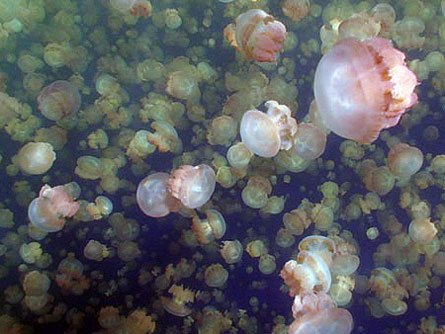Churning the numbers
Motion of ocean’s small swimmers may be important for climate modeling
- More than 2 years ago
To view video of a jellyfish and the water that flows around it as it swims, click here.

Small ocean dwellers like krill don’t idly go with the flow. In fact, the water around such animals flows with their go, new research has found, suggesting tiny swimmers may have a big impact on ocean mixing.
Energy put into the oceans by small animals is a significant component of the total contributed by all swimming creatures, adding up to a force comparable to that of winds and tides, scientists report in the July 30 Nature. The research suggests that scientists modeling global climate processes may need to add the contribution of such swimmers to the mix.
The analysis “doesn’t leave a lot to doubt — it’s very convincing,” says oceanographer William Dewar of Florida State University in Tallahassee, who wrote a commentary in Nature on the new research.
Scientists had previously thought that tiny, shrimplike copepods, or even animals such as fist-sized jellyfish, had little influence on ocean mixing. Any turbulence created by these small creatures would quickly dissipate, quashed by the viscosity of the water, which is thick like honey at the copepod scale. But a combination of fieldwork, theoretical modeling and energy calculations reveals that generating a wake isn’t the only way to stir the waters. Swimmers also drag fluid with them as they move, and this effect is especially enhanced in the viscous setting of the small scale, the new research found.
It’s similar to “drafting,” the technique used by bicyclists to catch the draft of a vehicle in front of them, says John Dabiri of the California Institute of Technology in Pasadena, who led the new study. The vehicle or rider in front carries the air that envelops them; similarly, a creature moving through water carries fluid along.
When a swimmer moves through water of different temperatures — as krill do each night when they migrate en masse from deeper waters to the surface — the cold water that goes along for the ride is mixed with any warmer water higher up.
For many years scientists considered an animal’s wake the main biological kinetic energy input to the oceans. But turbulence from a wake wasn’t considered that significant, especially for small creatures or super-efficient swimmers like dolphins, which leave little wake.
But even though wake is diminished at small scales, the amount of water carried with the swimmer is significant, the new work shows. In fact, small creatures carry more water with them per their bodies’ volume than large creatures do, because what for them is “thick” water gets dragged along even more. Charles Darwin’s grandson, physicist Charles Galton Darwin, first described how fluid travels along with a solid body in motion in the 1950s.
In addition to doing theoretical modeling, Dabiri’s team traveled to the island of Palau in the South Pacific to investigate the fluid dynamics of mixing by the local jellyfish Mastigias. By squirting a fluorescent dye in front of the swimming jellyfish, the scientists tracked the flow of water moving along with the jellies. A laser device recorded the jellies’ velocities.
Calculations suggest that the amount of ocean power input from all sea creatures may be as much as a trillion watts, Dabiri says, comparable to the power input from winds and tides. That calculation doesn’t include the contribution of fecal pellets and other debris that drift down through the water column, he adds.
Even small movements may add up to a serious role in the cycling of heat and carbon in the oceans, important factors influencing global climate. “We need to rethink circulation,” Dabiri says. “It’s more than winds and tides.”
Dyed water gets dragged along with swimming jellyfish before dispersing in their wake.
Credit: K.Katija/J.Dabiri






